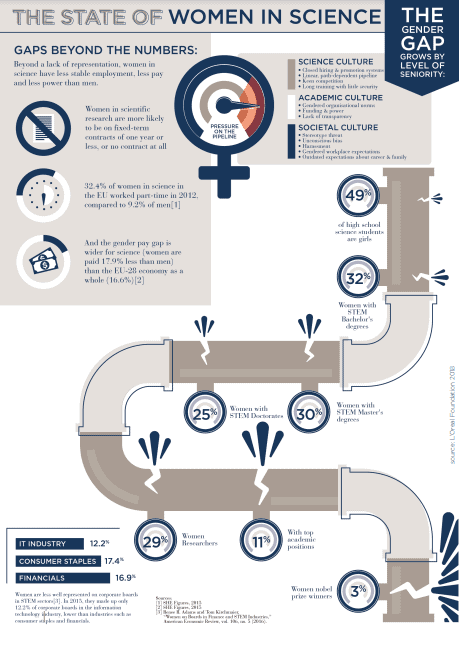Let’s Talk Statistics
Women and racial minorities are commonly underrepresented in the STEM field. According to The State of U.S. Science and Engineering (2020), only 29% of the science and engineering workforce was women despite making up roughly 52% of the national population (National Science Board, National Science Foundation, 2020). With even less representation, Latinx and Hispanic folks make up 16% of the United States’ population, but only 8.6% of the STEM workforce identify as Hispanic/Latino.
In recent years, the trends of these groups have grown, but not at the same rates as other demographics within STEM and they remain drastically underrepresented in their fields. Of all STEM occupations, engineering has the lowest representation of women. Similarly, only 9.2% of Hispanics/Latinx individuals in STEM careers are engineers, and only 8.6% hold a STEM degree as their highest degree earned. As a result of this inadequate representation in STEM, only 2.3% of all STEM degrees awarded in 2016 went to Hispanic and Latinx women.
Leaky Pipeline/Broken Pathway
The leaky pipeline is a metaphor for the gradual loss of women and racial minorities in STEM. The hurdles that these individuals face can lead to this outcome. There are some conflicting and problematic issues that arise when naming this situation, the leaky pipeline because a “leaky pipeline” implies there are “leaks” that may only have one cause or only one solution. In reality, the reasons for this pipeline effect are complicated and will require critical thinking and self-correction from individuals and institutions of power before the drastic change can happen.
For the purpose of this blog, we will refer to it as the “broken pathway” as it can better describe this phenomenon. First, let’s address that there are a number of broken pathways within STEM for women and racial minorities: the broken path of K-12 involvement/exposure to STEM degrees, the broken path from bachelor’s degrees to graduate degrees, and the broken paths between STEM degrees and STEM careers. It is also worth mentioning that these paths look different for women, racial minorities, and every individual. As mentioned, the reasons for the broken paths are not simple issues and are a result of intersectional problems that will need complex solutions to repair.
One major problem with the “leaky pipeline” narrative is that it assumes that those who leave STEM are lost to the STEM field entirely. Not everyone who leaves a STEM education or career is gone from the industry. Those individuals are still capable of change and tremendous contributions in non-traditional ways using their STEM-related skills and education.
There are some ways that we can help combat these broken pathways for students and young professionals:
- Camaraderie: SWE is already an incredible resource for battling the broken pathways students face. Having a community of women to support, engage, and help each other has proven successful in retaining women in STEM; additionally, SWE has affinity groups to help further support and connect a network of people with similar identities and career paths.
- Mentoring: this is another thing SWE excels at! Mentoring and shadowing STEM careers at a young age can help young people seem themselves in the shoes of their mentors. It is hard to picture yourself as something you’ve never seen before.
- STEM Outreach Programs: SWE has a hand in this with SWENext working to encourage young girls into STEM careers and supports their interests and curiosity in STEM. Programs like these are incredibly important for showing the possibilities of a STEM career to students. However, these programs need to become available to students of all identities and zip codes, as sometimes lower socioeconomic or areas with large populations of Black, Indigenous, and people of color are lacking these types of programs.
- Advocates & Sponsors: undoubtedly there are men who advocate for the success of women and racial minorities in STEM, but there are not enough. There needs to be a stronger force of men who will encourage and step aside for those who are capable and qualified to join into conversations and efforts that they belong in. Men make up ~50% of the population, so in order to achieve full equity, we need that portion of the population to leverage their power as allies. Additionally, women in positions of power can help to lift the voices of those around them.
Further reading for ways to stop and mend these broken pathways can be found in the resources below:
Ash, J., Kapp, J., Bernal, B. (2019, March 20). Fixing the Leaky Pipeline: The Importance of Women’s Success in STEM. National Women’s History Museum. https://www.womenshistory.org/articles/fixing-leaky-pipeline
Cullinane, J., Leegwater, L.H. (2009, December 3). Diversifying the STEM Pipeline: The Model Replication Institutions Program. Institute for Higher Education Policy. http://ihep.org/research/publications/diversifying-stem-pipeline-model-replication-institutions-program
For Women in Science. (2018, March 22). Tectonic Movements: How cultural shifts can lift up women in science. Foundation L’Oreal. https://www.fondationloreal.com/documents/67a87e7d-bf6e-4964-b232-45b2b6c503f5/download?lang=fr
Larkin, M. (2014, February 12). STEM diversity initiatives – what works and what doesn’t. Connect. Elsevier. https://www.elsevier.com/connect/stem-diversity-initiatives-what-works-what-doesnt
National Science Board, National Science Foundation. 2020. Science and Engineering Indicators 2020: The State of U.S. Science and Engineering. NSB-2020-1. Alexandria, VA. Available at https://ncses.nsf.gov/pubs/nsb20201/.
Related Content:
- Podcast: Celebrating Hispanic Heritage with Latina Leader, Eileen Vélez-Vega
- Celebrating Hispanic Heritage Month
- Biomedical Engineering Spotlight: Mallory Gullett
Author
-

SWE Blog provides up-to-date information and news about the Society and how our members are making a difference every day. You’ll find stories about SWE members, engineering, technology, and other STEM-related topics.






